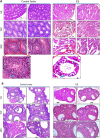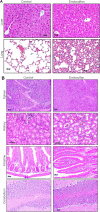Exposure to endosulfan can cause long term effects on general biology, including the reproductive system of mice
- PMID: 36506329
- PMCID: PMC9729358
- DOI: 10.3389/fgene.2022.1047746
Exposure to endosulfan can cause long term effects on general biology, including the reproductive system of mice
Abstract
Increased infertility in humans is attributed to the increased use of environmental chemicals in the last several decades. Various studies have identified pesticides as one of the causes of reproductive toxicity. In a previous study, infertility was observed in male mice due to testicular atrophy and decreased sperm count when a sublethal dose of endosulfan (3 mg/kg) with a serum concentration of 23 μg/L was used. However, the serum concentration of endosulfan was much higher (up to 500 μg/L) in people living in endosulfan-exposed areas compared to the one used in the investigation. To mimic the situation in an experimental setup, mice were exposed to 5 mg/kg body weight of endosulfan, and reproductive toxicity and long-term impact on the general biology of animals were examined. HPLC analysis revealed a serum concentration of ∼50 μg/L of endosulfan after 24 h endosulfan exposure affected the normal physiology of mice. Histopathological studies suggest a persistent, severe effect on reproductive organs where vacuole degeneration of basal germinal epithelial cells and degradation of the interstitial matrix were observed in testes. Ovaries showed a reduction in the number of mature Graafian follicles. At the same time, mild vacuolation in liver hepatocytes and changes in the architecture of the lungs were observed. Endosulfan exposure induced DNA damage and mutations in germ cells at the molecular level. Interestingly, even after 8 months of endosulfan exposure, we observed increased DNA breaks in reproductive tissues. An increased DNA Ligase III expression was also observed, consistent with reported elevated levels of MMEJ-mediated repair. Further, we observed the generation of tumors in a few of the treated mice with time. Thus, the study not only explores the changes in the general biology of the mice upon exposure to endosulfan but also describes the molecular mechanism of its long-term effects.
Keywords: DNA repair; double-strand break; endosulfan; genomic stability; infertility; oogenesis; reproductive toxicity; spermatogenesis.
Copyright © 2022 Sharma, Kaninathan, Dahal, Kumari, Choudhary and Raghavan.
Conflict of interest statement
The authors declare that the research was conducted in the absence of any commercial or financial relationships that could be construed as a potential conflict of interest.
Figures









Similar articles
-
NTP technical report on the toxicity studies of Dibutyl Phthalate (CAS No. 84-74-2) Administered in Feed to F344/N Rats and B6C3F1 Mice.Toxic Rep Ser. 1995 Apr;30:1-G5. Toxic Rep Ser. 1995. PMID: 12209194
-
Endosulfan induces reproductive & genotoxic effect in male and female Swiss albino mice.Lab Anim Res. 2024 May 22;40(1):22. doi: 10.1186/s42826-024-00208-4. Lab Anim Res. 2024. PMID: 38773665 Free PMC article.
-
Interactive effects of ultraviolet-B radiation and pesticide exposure on DNA photo-adduct accumulation and expression of DNA damage and repair genes in Xenopus laevis embryos.Aquat Toxicol. 2015 Feb;159:256-66. doi: 10.1016/j.aquatox.2014.12.004. Epub 2014 Dec 12. Aquat Toxicol. 2015. PMID: 25569846
-
Bioaccumulative potential and toxicity of endosulfan insecticide to non-target animals.Comp Biochem Physiol C Comp Pharmacol Toxicol. 1993 Jul;105(3):347-61. doi: 10.1016/0742-8413(93)90071-r. Comp Biochem Physiol C Comp Pharmacol Toxicol. 1993. PMID: 7900959 Review.
-
An assessment of the developmental, reproductive, and neurotoxicity of endosulfan.Birth Defects Res B Dev Reprod Toxicol. 2009 Feb;86(1):1-28. doi: 10.1002/bdrb.20183. Birth Defects Res B Dev Reprod Toxicol. 2009. PMID: 19243027 Review.
Cited by
-
The adverse role of endocrine disrupting chemicals in the reproductive system.Front Endocrinol (Lausanne). 2024 Jan 17;14:1324993. doi: 10.3389/fendo.2023.1324993. eCollection 2023. Front Endocrinol (Lausanne). 2024. PMID: 38303976 Free PMC article. Review.
-
The Impact of Organic Micropollutants on the Biochemical Composition and Stress Markers in Wolffia arrhiza.Molecules. 2025 Jan 21;30(3):445. doi: 10.3390/molecules30030445. Molecules. 2025. PMID: 39942550 Free PMC article.
References
-
- Atsdr A. Z. (2000b). Toxicological profile for endosulfan. Atlanta: Ga.
-
- ATSDR (2000a). Toxicological profile for endosulfan. Atlanta, Ga: US Department of Health and Human Services, Public Health Service, Agency for Toxic Substances and Disease Registry. - PubMed
-
- Badiger S., Jacob A. M., Bangaraiah A. S., Bhandary S. K., Hegde S., Kumar P. (2019). A study on the distribution of disabilities among the population residing in the Endosulfan exposed area in Dakshina Kannada district of Karnataka. Int. J. Community Med. Public Health 6 (9), 3948. 10.18203/2394-6040.ijcmph20193999 - DOI
LinkOut - more resources
Full Text Sources
Research Materials

